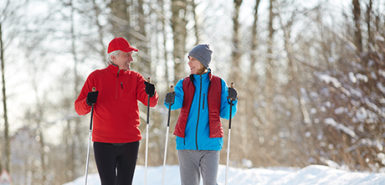
Sleep apnea is the Kevin Bacon of health disorders.
Just as nearly every actor in Hollywood has at one time or another rubbed elbows with Mr. Footloose, there’s scarcely a disorder out there that isn’t somehow associated with sleep apnea.
Hypertension. Diabetes. Stroke. Atrial fibrillation. Panic disorder. It’s even connected to post-op problems and death itself.
And there are many more, too extensive to list.
“Almost everything that we look at seems to have some relationship with sleep apnea, as far as health conditions that are studied,” said Jason Coles, MD, a sleep medicine specialist at Spectrum Health. “(Sleep apnea) seems to unleash a cascade of changes within the vascular system, which leads to more (problems).”
The big question: Does sleep apnea actually cause these problems, or is it simply associated with these problems? Or, is it a byproduct of these problems?
It could be any one of these. It all depends on the patient and the ailment.
But no matter what the case, the upshot of treating sleep apnea is it can help alleviate existing ailments and potentially avoid the onset of new ones.
“There’s always kind of a chicken-and-the-egg question,” Dr. Coles said. “People who are heavy tend to have sleep apnea. People who are heavy also tend to have high blood pressure. But, as we look at it, it does appear that sleep apnea itself—even without those other factors—does raise the risk.”
Sleep apnea can strike anyone, although overweight men ages 40 and older tend to be most at risk. (Obesity, coincidentally, is present in about half of the 18 million Americans who have sleep apnea.)
“People who have sleep apnea typically get it because either they have a large neck size, which makes that space in the back of the airway smaller, or their jaw is set back a little bit, which makes that space in the back of the throat a little bit smaller,” Dr. Coles said.
Obstructive sleep apnea occurs when the muscles in the throat relax after falling asleep, causing the space at the back of the airway to narrow, Dr. Coles explained. The sleeper either stops breathing or has partial breathing obstructions for short periods, which starves the brain and body of oxygen and increases carbon dioxide levels. Sleep is also interrupted with each event.
People with narrow mouths may also be at greater risk of sleep apnea. “Some people get it even though we take a look in their throat and everything, anatomically, is very normal,” Dr. Coles said.
Connections
Sleep is essential to the proper function of the body. When sleep is disrupted—quality or quantity—it can wreak havoc on other systems.
“Everything seems to tie back to sleep,” Dr. Coles said.
It’s like that old children’s song, “The knee bone is connected to the thigh bone.” Every function relates to another in the human body. When a problem arises in one spot, it’s likely to spill into another spot if it’s not soon remedied.
“If sleep is not normal, it really does affect us across the board,” the doctor said. “It’s a kind of healing and maintenance of healthy systems.
“It’s important for consolidation of memory, it’s important for mood,” he said. “There’s evidence that if we’re not sleeping well it does, in fact, affect the body’s endocrine system, (immune) resistance and the cardiovascular system.”
There’s evidence, too, that sleep apnea can lead to changes in insulin resistance, a precursor to diabetes. There’s also a greater risk of heart attack and stroke.
“The big ones that have the most evidence behind them are high blood pressure, diabetes, heart attack and stroke,” Dr. Coles said.
“The other big and new area that’s getting a lot more attention is the link to abnormal heart rhythms like atrial fibrillation, in particular,” he said. “That’s something where there seems to be evidence that treating the sleep apnea helps with those sorts of problems as well.”
In a recent study in the Annals of Family Medicine, researchers also established a link between sleep apnea and panic disorder.
“It makes sense,” Dr. Coles said.
Mental and biological processes can cause a person with panic disorder to experience anxiety, which triggers the release of more adrenaline, which becomes self-perpetuating.
A similar dynamic can happen during sleep. For some people with panic disorder, in fact, panic attacks only happen in sleep.
“Sleep apnea causes the release of a lot of adrenaline in our sleep,” the doctor said.
Ordinarily, a person’s heart rate is slower and the blood pressure is lower during sleep. “We’re in a low adrenaline state,” Dr. Coles said.
“Sleep apnea actually causes the opposite because the airway is obstructed,” he said. “The body thinks it’s being choked, and so people wake up with a fast heart rate and anxious feelings that may prompt panic attacks. It definitely could trigger that.”
Sleep apnea is also linked to depression, according to one CDC study.
Symptoms, treatments
Sleep apnea’s symptoms often arise gradually. They’re also sometimes ambiguous.
“What makes it challenging is these symptoms develop really slowly over the course of years,” Dr. Coles said. “So a lot of people blame it on getting older, especially if they’re tired all the time.”
One problem doctors have encountered: sleep apnea sufferers who live alone.
“By definition, (sleep apnea) is only happening when we are asleep,” Dr. Coles said. “If you live alone, it’s hard to know.”
It’s helpful to learn about the classic symptoms of sleep apnea, including nighttime and daytime symptoms. The most common reason people with sleep disorders seek help is because they feel constantly fatigued and drowsy, Dr. Coles said.
“If someone is having trouble staying awake during the day, it would be a big red flag,” he said. “If they’re finding themselves dozing off more while watching TV or reading, or especially if they’re getting sleepy with driving, that would be a big red flag.”
Problems with brain function—memory, concentration and such—are also indicators.
Other warning signs include nighttime restlessness, tossing and turning, waking up frequently to urinate—“that’s a big one that people don’t realize is tied to sleep apnea,” Dr. Coles said—morning headaches and feeling unrested first thing in the morning.
If a patient has severe sleep apnea, there’s good reason to believe their blood pressure is up. And high blood pressure increases the risk for heart attack, stroke and diabetes. But these existing conditions can be improved when the sleep apnea is treated.
“There’s good evidence that treating (sleep apnea) seems to reduce the risks (overall),” he said.
The best sleep apnea treatment is a continuous positive airway pressure device, or CPAP, a machine that blows air into a mask worn by the patient during sleep.
“The CPAP has been kind of a mainstay,” Dr. Coles said.
In many cases, surgery or dental appliances are used. One of the more interesting recent treatments, however, is hypoglossal nerve stimulation.
“The newest thing is more in the surgical domain,” the doctor said. “There’s the recent development of stimulators called hypoglossal nerve stimulators.”
Researchers found that mild electrical stimulation of the hypoglossal nerve can reopen the airway muscles that are normally blocked during sleep apnea. The implantable stimulator fires each time there’s a blockage, reopening the airways.
“There’s pretty good evidence that that really seems to help sleep apnea,” Dr. Coles said. “I think that’s a really exciting avenue for the future.”
 /a>
/a>
 /a>
/a>
 /a>
/a>
Great and informative post!